Bell peach: description, cultivation and reproduction

Delicate peach-leaved bell flowers occasionally adorn forest glades and ravines. The wild plant is listed in the Red Book. However, thanks to the efforts of breeders, a cultivated flower can also be grown in a summer cottage. Our article will tell you how to plant this beautiful plant and how to care for it.
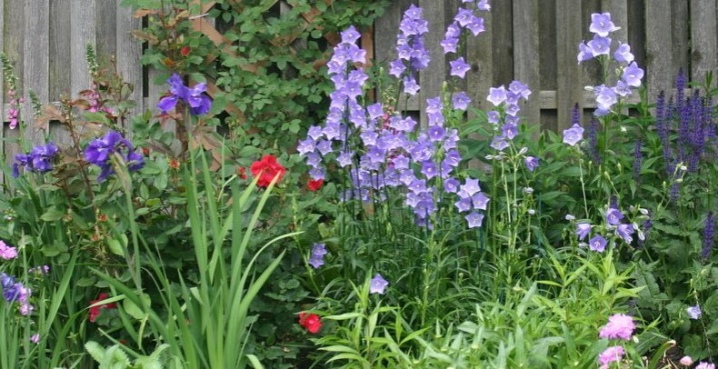
Description
Peach bell (Campanula persicifolia) is a perennial crop. To date, several varieties have been bred, differing in colors and some characteristics.
Plant height can range from 40 to 120 centimeters. Varieties of medium height are more common. The stem grows straight and has a slightly ribbed structure. In the process of flower maturation, it becomes lignified. The root system of the culture is twisted, branching... Because of this, it is quite difficult to pull a flower out of the ground by its roots.
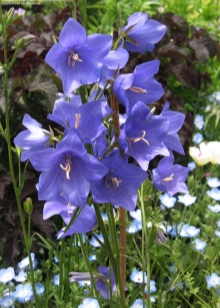
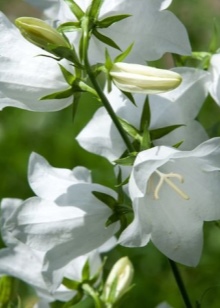
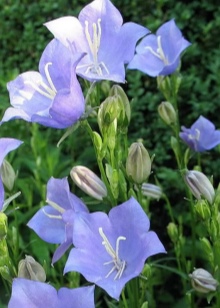
Leaves resemble peach in appearance. This is the reason for the name of the culture. They are rarely located on the stem. They have a harsh structure and an elongated shape.
The main decoration of the plant is graceful flowers attached to the stem with short legs.
They are funnel-shaped, drooping slightly in most varieties. The diameter of each flower can be from 3.5 to 4 cm. Each includes 5 petals. Inside the flower is a gland containing nectar. It is he who attracts pollinating insects.
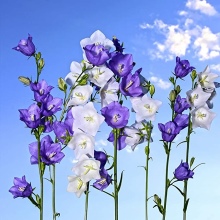
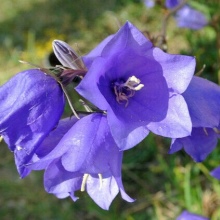
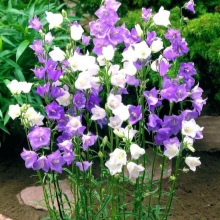
Inflorescences are one-sided brushes. They usually consist of 3-7 flowers. This allows the plant to be highly decorative despite the lack of lush foliage. Interestingly, the buds close late in the evening and on rainy days.
The color range of the petals is varied. In nature, blue, blue, purple flowers are usually found. Garden varieties are also lilac, yellowish and snow-white.
The flowering period of the culture - from June to early September. The specific time frame depends on the variety. After the end of flowering, seed pods appear on the plants, allowing the culture to propagate.
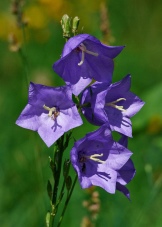
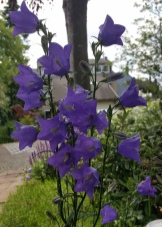
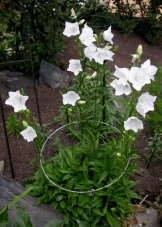
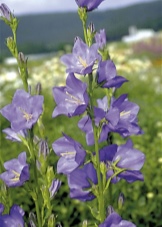
Varieties
Consider several popular varieties of peach bell.
Takion blue
It is a beautiful variety of medium height (about 50 cm). The flowers are blue with a purple tint. At the edges, the tone of the petals is more saturated, and in the center it is lighter. A feature of the variety is the position of the flowers on the bush. Unlike many varieties with drooping buds, here they are directed upward, which enhances the decorative effect of the culture.
The variety blooms early. The first buds can be seen already at the end of spring. After pruning, the plant blooms again.
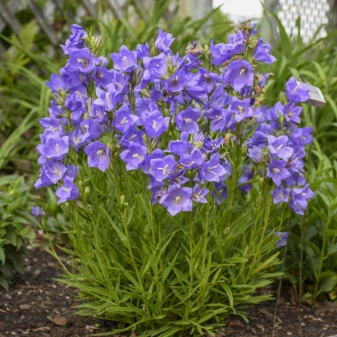
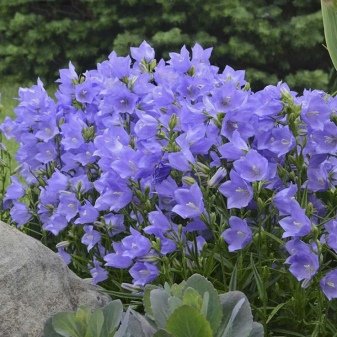
La belle blue
This variety is distinguished by its blue double flowers. The maximum plant height is 60 cm. The culture begins to bloom in July and pleases with a delightful appearance throughout August. Flowers of this variety prefer sunny places.



"Snow White"
This variety can be called quite tall - the plant can reach 80 centimeters. The bush turns out to be very voluminous and lush (in width it grows to almost the same size as in height). Dazzling white flowers appear on the plant in large numbers.
The culture blooms from mid-June to late August. Flowering peaks in the first 2 weeks. A spectacular bush at this time resembles a large snow-white cloud.
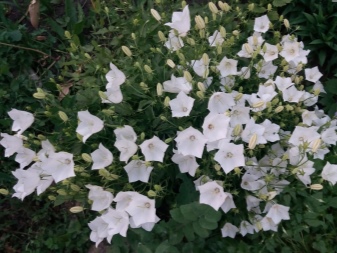

"Alba captivity"
It is a luxurious variety with double white flowers.Large buds are sent to the sides and down. The culture grows up to 50 cm. It reaches only 20 cm in diameter, but this does not affect the decorativeness of the plant. Such a flower becomes a real decoration of the site.
The leaves of the plant are dark green, with a beautiful shine. Flowering begins in June and lasts until the end of July.
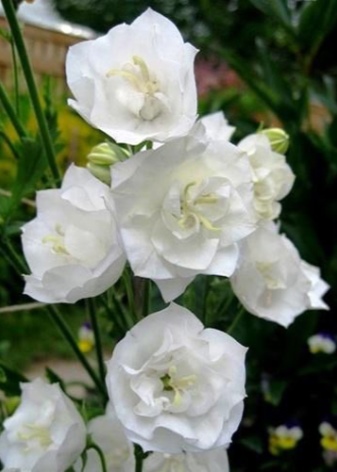
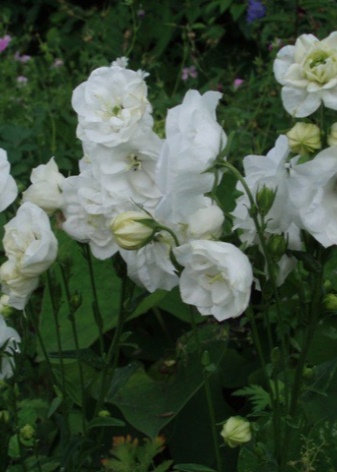
How to choose?
For each grower, the choice of culture is completely dependent on personal preference. If you want to bloom all summer long, you can opt for a variety Takion blueas it blooms again.
You should pay attention to a number of nuances. For example, how the area is located, whether there is a lot of sun or more shadow on it. How deep the groundwater goes. The terrain is flat or mountainous. How much the area is planted with other crops.
In order to decorate and emphasize garden paths, it is worth choosing low varieties.
In a bright single planting, a tall one will look good "Snow White".

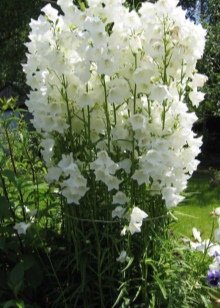

When purchasing planting material in the store, carefully examine it. The plant should look healthy and the roots should not be damaged. The best option is to buy a flower along with an earthen clod, then the likelihood of damage to the root system during transplantation is reduced.
Having decided to plant the bell with seeds, it is better to purchase them in a specialized store. This will increase the likelihood of obtaining varietal plants. In this case, the main thing is to plant the bell correctly.
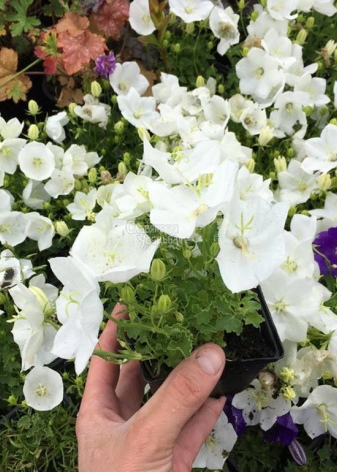
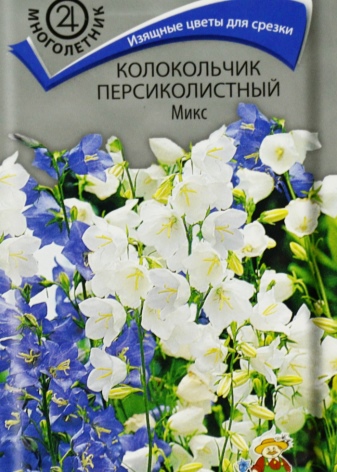
Landing
The site must be well lit. Light partial shade is also allowed. As for the soil, it should be loose and preferably fertile. If natural drainage is not enough, you need to create it artificially. The accumulation of moisture in the root system is undesirable, therefore, it is worth choosing a site with deep groundwater.
The ideal solution would be a hill. Level terrain is also fine. A month before planting, the land is enriched with humus, lime, as well as preparations containing phosphorus and potassium. This is especially true for poor soils.
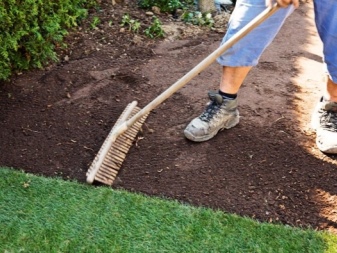
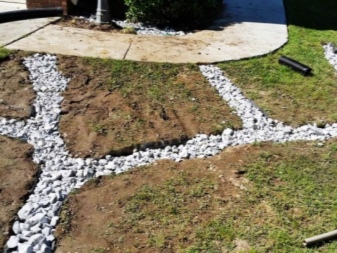
Planting in open ground is carried out at a distance that depends on the particular variety. If tall flowers are chosen, leave 50 cm between them.For small bells, 30-40 cm is enough.
The plant is planted in a previously dug hole with drainage at the bottom. Well, if there is an earthen lump, then planting is done by the transshipment method. If the roots are open, they are straightened, then covered with soil mixture, lightly tamped and watered.
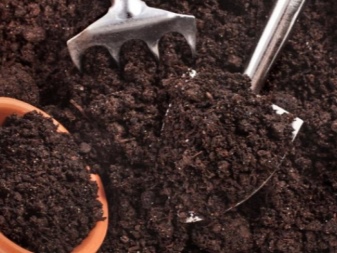
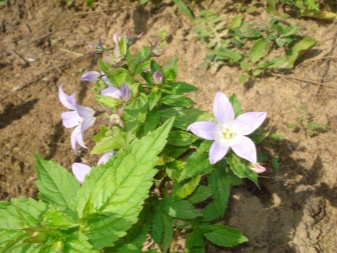
Follow-up care
After planting the plant in open ground, you should properly care for it so that the bell takes root.
Watering
The culture needs moderate watering, which is produced as the soil dries. After irrigating the soil, loosen it carefully.
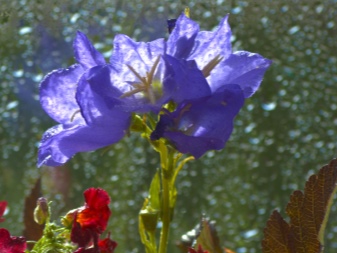
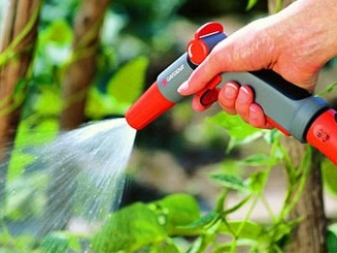
Top dressing
When the plant reaches 2 years of age, it should be fertilized. At the beginning of the season, a nitrogen composition is added. It promotes a set of vegetative mass. You can put some wood ash on top.
During the flowering period, the land is enriched with preparations with phosphorus. Complex formulations can also be used. In the fall, the bell is fed with potassium. This contributes to the winter hardiness of the plant.
Three dressings per season will be enough. You should not overdo it with fertilizers - because of their excess, the culture ages faster, and also becomes less resistant to cold.
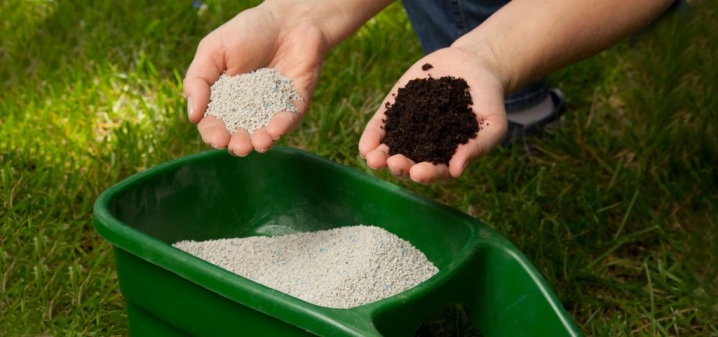
Weeding
Weeds need to be eliminated in a timely manner. Otherwise, they will prevent the flow of sufficient oxygen to the roots of the flower.
And also it is necessary to monitor the condition of the bell itself. Dried flowers are best removed immediately. In this case, new ones appear in their place faster. You can leave only those flowers from which you plan to collect seeds.
If the crop is tall, the faded shoots should be cut off completely. And also for such plants it is important to provide a support to which the flowers are tied.

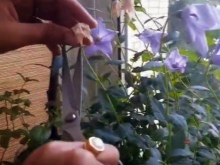
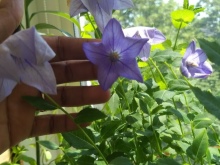
Preparing for winter
In the fall, it is important to prepare flowers for wintering. At the end of September, all the stems of the bells are cut to ground level. Most varieties are winter hardy and do not need shelter. But still, many gardeners are reinsured. The culture is sprinkled with peat, which protects the root system from the cold. Fallen leaves or spruce branches can also be used as mulch.
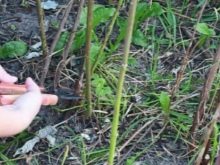
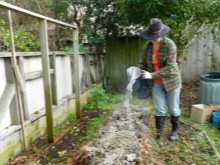

Disease and pest control
Some adult plants may be affected fungal diseases. In such cases, the leaves may dry out or become stained. The situation can be corrected by spraying the crop with Oxyhom.
If the summer is wet, the bell can be attacked by leafhoppers. The risk is increased if the flower grows in the shade. To prevent the plant from dying, you need to spray with garlic water. Fitoverm will also be useful.
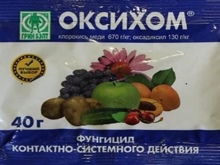
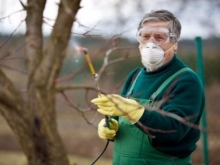

Reproduction
In addition to growing from seeds and the seedling method, the peach bell can be propagated by division and cuttings.
Growing from seeds
Seed material can be purchased at a specialty store. If there is already a bell on the site, you can collect the seeds yourself. In this case, at the end of summer, the faded box is dried. Then the seeds are extracted from it. This should be done after browning, but before opening the boxes on your own, this will avoid accidental self-seeding.
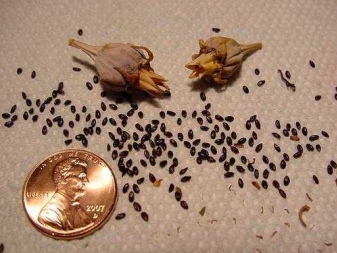
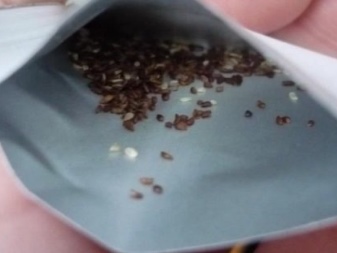
Seeds are sown on the site at the end of May.
After sowing, they are covered with foil. You can carry out the procedure in October. It is only important to be in time before the frost. In the second case, the gardener will see the flowering of the culture next year.

Seedling method
The process starts at the end of April. Ground is poured into the prepared containers with the addition of a small amount of humus and sand. And you can also go the other way by buying a ready-made seedling mixture in the store.
The surface of the soil is sprayed with a spray bottle. Then the seed is laid and lightly sprinkled with earth. A thin layer of 2 mm is sufficient. After that, the planting is moistened again. On the box put on polyethylene, creating a greenhouse environment. At the same time, the seedlings are periodically ventilated.
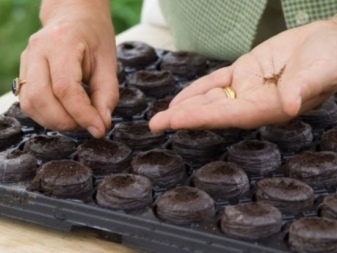
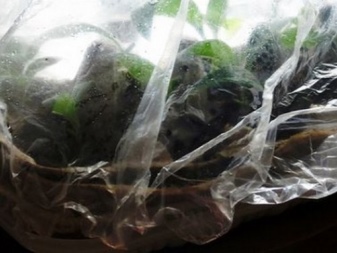
The boxes should be located in a room with normal room temperature. Seedlings will appear after 2-3 weeks. When the seedlings are visible by 3 mm, the film is removed. Young plants are regularly sprayed up to the first leaves.
When 2 or 3 leaves appear on each seedling, a pick is started. It is important not to miss this moment. Otherwise, the roots of adjacent shoots may overlap. In this case, their separation can cause irreparable harm to the flowers.
Young bells are seated in separate cups. If this is not possible, they are placed in a larger container with a distance of at least 10 cm between specimens.
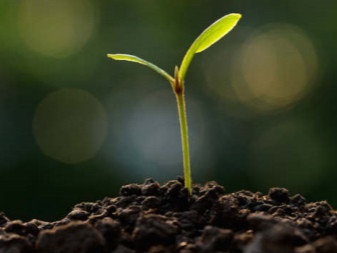
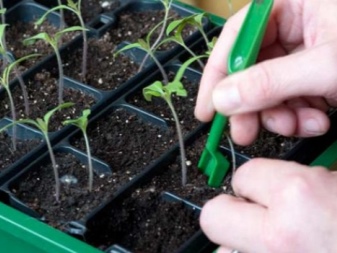
Dividing the bush
This method is applicable only to adult specimens that have reached the age of 3-5 years. The process starts in May. You can carry out the procedure in the fall. The stems are cut, the flower is carefully dug up.
Then the root of the plant is divided into 2 or 3 pieces using a sharp knife. It is important to make sure that the kidneys remain on each part. After this, the places of the cuts are "powdered" with wood ash. Crushed coal can also be used.
The transplant is carried out immediately. Choose suitable sites with good soil. The kidney processes should remain at ground level. After planting, the plants are watered. The soil around each seedling is carefully compacted.
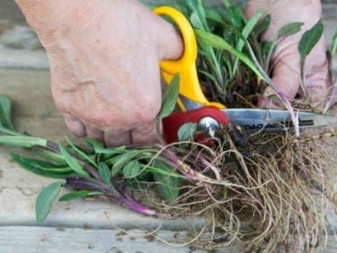
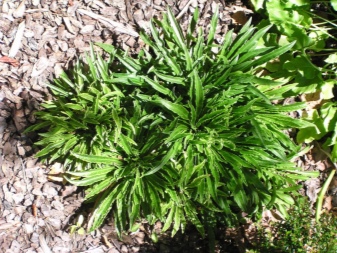
Cuttings
Like the method of dividing, propagation by cuttings allows you to preserve the varietal qualities of the mother bush. By the way, seed reproduction does not give such a guarantee. The procedure is usually carried out in the spring. But you can do this at any time during the summer.
Cuttings are taken from the middle of the stem. For this, both young and already lignified shoots are suitable. The main thing is that the length is at least 10 cm.


The leaves located on the cuttings are cut to the middle. Then the planting material is placed in a permanent place in the open ground. Sometimes the cutting is first planted in a greenhouse until it takes root.
If the future flower remains on the street, it is covered with a transparent plastic container of sufficient height. You can use a cut bottle. Rooting takes place within three weeks.
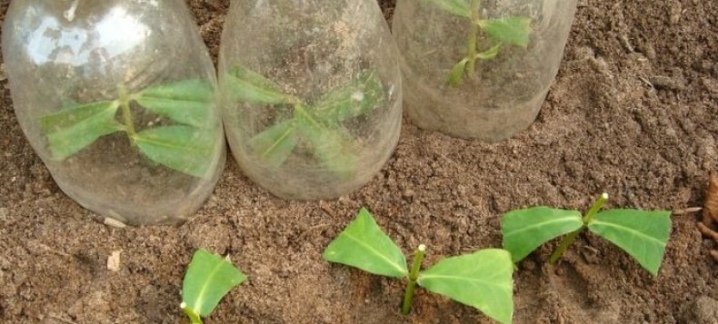
Beautiful examples in landscape design
Bells are good in both single and group plantings. They look great in rock gardens, in flower beds in the company of other flowering crops. They are combined with green low-growing plantings.
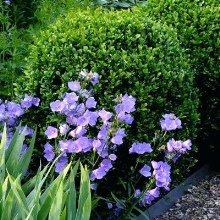
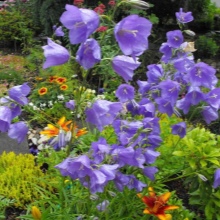

Very effective compositions are obtained by combining white and blue bells in one area. You can plant delicate bushes along the paths or near the fence. Small varieties are suitable for creating borders. You can also grow the culture in containers.

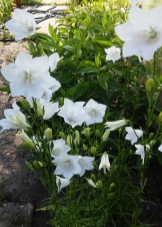
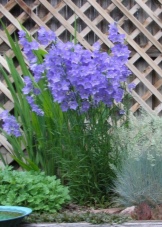
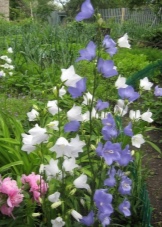
An overview of the peach bell can be seen in the following video.







































































































The comment was sent successfully.